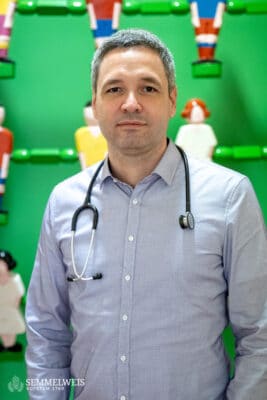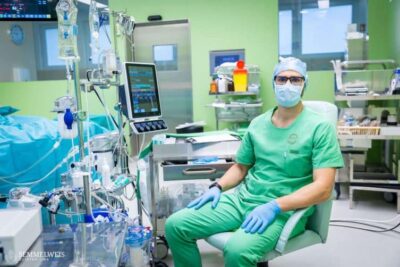 Pediatric rheumatological conditions are among the most common chronic autoimmune diseases in childhood, although chronic diseases are much less frequent in children than in adults. A milestone in the treatment of this disease was reached in 2013 with the opening of the first biological therapy center operating within a pediatric healthcare institution. This center is located at the Tűzoltó Street Department of the Pediatric Center. Thirty patients are treated here every day, and over the past 12 years, more than 10,000 children with rheumatic diseases have been given the chance to enjoy a better quality of life. Biological therapies have brought about a breakthrough: While a few decades ago, those affected were forced to live with severely limited mobility as adults, their life prospects are now the same as those of healthy children.
Pediatric rheumatological conditions are among the most common chronic autoimmune diseases in childhood, although chronic diseases are much less frequent in children than in adults. A milestone in the treatment of this disease was reached in 2013 with the opening of the first biological therapy center operating within a pediatric healthcare institution. This center is located at the Tűzoltó Street Department of the Pediatric Center. Thirty patients are treated here every day, and over the past 12 years, more than 10,000 children with rheumatic diseases have been given the chance to enjoy a better quality of life. Biological therapies have brought about a breakthrough: While a few decades ago, those affected were forced to live with severely limited mobility as adults, their life prospects are now the same as those of healthy children.
Thanks to modern, targeted treatments, the outcome of the disease, children’s quality of life, opportunities, and prospects have greatly improved, says Dr. Tamás Constantin, Head of the Pediatric Rheumatology Unit at Semmelweis University, the only dedicated pediatric rheumatology inpatient ward in Hungary. He cites an international study showing that before the 2000s, prior to the introduction of biological therapies, up to two-thirds of affected patients had undergone some form of surgical intervention by young adulthood and were living with prostheses. A few decades later, the impact of the disease was reexamined. At that time, only one percent of patients had undergone surgery thanks to biological therapy.
Better treatments are becoming available, and these new therapies have transformed a previously incurable disease leading to severe mobility impairment into a treatable, manageable condition. Although children with this condition need to receive regular treatment, their functional abilities are almost identical to those of children not affected by it.
Pediatric rheumatology treats chronic joint inflammation in children, which is commonly referred to as “rheumatic disease” in adults. Chronic joint inflammation and its various forms are the most common autoimmune disease in childhood affecting approximately 3,000 to 5,000 children in Hungary today.
These diseases have multifactorial causes. As there are several reasons behind their development, there is no causal treatment option. Currently, symptomatic treatment mainly involves infusions and injections. However, some oral medications have also become available, and their number is likely to increase, explains Dr. Tamás Constantin.
The chief physician adds that pediatric rheumatic diseases also include various systemic autoimmune diseases (e.g., lupus), periodic fever syndromes, and various types of vasculitis. One of the most serious, but fortunately rare conditions among the latter is vascular disease which causes the majority of childhood strokes.
From December 11 to 13, a conference is being organized under the coordination of Semmelweis University’s Pediatric Center and with the participation of experts (pediatric rheumatologists, neurologists, radiologists) from fifteen countries, including the USA, Canada, and Spain. At the event, participants plan to issue an international recommendation for the treatment of childhood cerebral vasculitis. This is a very severe condition for which limited data and test results are available. Therefore, the emerging consensus and expert recommendations will be of great importance for the treatment of the disease.
According to the pediatric rheumatologist, thanks to advances in treatment options, half of affected children may experience a complete disappearance of the inflammatory process by adulthood. The other half, however, may require treatment even after the age of 18.
Orsolya Dávid
Translation: Judit Szabados-Dőtsch
Photos by Attila Kovács – Semmelweis University


